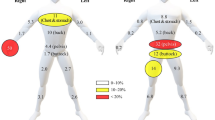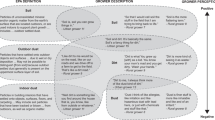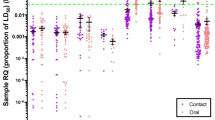Abstract
Strawberry harvesters hand-pick fruit that may result in pesticide exposure from hand foliar contact. This paper included a review of publications on harvester pesticide exposure, an observation of their work activities, and development of an alternative model for pesticide exposure prediction. Previous studies monitored the dermal pesticide exposure of strawberry harvesters and found most of the exposure (>70%) was on the hands. Exposure rates (ERs) were calculated as pesticide amount on the skin per hour worked, assuming foliar contact is proportional to daily work hours. Transfer factors (TFs), used for predicting exposure, were calculated by dividing the ER by the amount of dislodgeable foliar pesticide residue. However, the ERs for harvesters working in the same field at the same time varied by as much as 10-fold, and TFs calculated from different studies varied by up to 100-fold. We tested the assumption of foliar contact time being proportional to daily work hours. We observed full work-day activities of 32 strawberry harvesters. We found that their foliar contact time per work minute differed by up to 46%. We suggested using the amount of strawberries picked to predict harvester foliar contact. For all observed harvesters, their foliar contact time per kg of strawberries picked was 35±5 s. This value was similar among harvesters with varying years of experience, of different gender, and using gloves or not. We proposed a predictive model using the amount of strawberries picked to predict harvester pesticide exposure. The exposure predicted by the model is close to the exposure measured in previous monitoring studies (R2: 0.84). The model slope is 0.33±0.03 × 103 cm2/kg. Model prediction accuracy was confirmed by monitoring captan exposure to harvesters in two fields. The model may be used as a quick screening method to estimate pesticide exposure before conducting complex human monitoring research.
This is a preview of subscription content, access via your institution
Access options
Subscribe to this journal
Receive 6 print issues and online access
$259.00 per year
only $43.17 per issue
Buy this article
- Purchase on Springer Link
- Instant access to full article PDF
Prices may be subject to local taxes which are calculated during checkout





Similar content being viewed by others
References
United Nations Food and Agriculture Organization Statistics Division Production quantities by crops United Nations Food and Agriculture Organization: Rome, Italy. 2013. Available at: http://faostat3.fao.org/browse/Q/QC/E.
U.S. Department of Agriculture Economic Research Service U.S. Strawberry Harvested Acreage, Yield per Acre, and Production, 13 States, 1970–2012. U.S. Department of Agriculture: Washington, DC. 2012. Available at: http://usda.mannlib.cornell.edu/MannUsda/viewDocumentInfo.do?documentID=1381.
California Department of Pesticide Regulation. Pesticide Use Reporting-2012 Summary Data Indexed by Commodity: Sacramento, CA, 2014. Available at http://www.cdpr.ca.gov/docs/pur/pur12rep/12_pur.htm.
Li Y, Chen L, Chen Z, Coehlo J, Cui L, Liu Y et al. Glove accumulation of pesticide residues for strawberry harvester exposure assessment. Bull Environ Contam Toxicol 2011; 86: 615–620.
Fernades VC, Lehotay SJ, Geis-Asteggiante L, Kwon H, Mol HGJ, van der Kamp H et al. Analysis of pesticide residues in strawberries and soils by GC-MS/MS, LC-MS/MS and two-dimensional GC-time-of-flight MS comparing organic and integrated pest management farming. Food Addit Contam A 2014; 31: 262–270.
Lanning CL, Wehner TA, Norton JA, Dunbar DM, Grosso LS . Correlation of actual strawberry harvester exposure with that predicted from abamectin dislodgeable foliar residues. J Agric Food Chem 1998; 46: 2340–2345.
Stamper JH, Nigg HN, Queen RM . Dislodgeable captan residues at Florida strawberry farms. Chemosphere 1987; 16: 1257–1271.
Giles DK, Blewett TC . Effects of conventional and reduced-volume, charged-spray application techniques on dislodgeable foliar residue of captan on strawberries. J Agric Food Chem 1991; 39: 1646–1651.
Krieger RI, Dinoff TM . Captan fungicide exposures of strawberry harvesters using THPI as a urinary biomarker. Arch Environ Contam Toxicol 2000; 38: 398–403.
Zweig G, Gao R, Witt JM, Popendorf W, Bogen K . Dermal exposure to carbaryl by strawberry harvesters. J Agric Food Chem 1984; 32: 1232–1236.
Maddy KT, Krieger RI, O’Connell L, Bisbiglia M, Margetich S Use of biological monitoring data from pesticide users in making pesticide regulatory decisions in California. In: Wang RG, Franklin CA, Honeycutt RC, Reinert JC (eds). ACS Symposium Series Biological Monitoring for Pesticide Exposure. American Chemical Society: Washington, DC. 1988 pp 338–353.
U.S. Environmental Protection Agency Office of Pesticide Programs Hazard Evaluation Division Pesticide Hazard Assessment Project: Harvester Exposure Monitoring Field Studies (1980-1986). Volume 2, A Collection of 25 Studies. U.S. Environmental Protection Agency: Washington, DC. 1988. Available at: http://www.epa.gov/nscep/index.html.
Zweig G, Gao R, Popendorf W . Simultaneous dermal exposure to captan and benomyl by strawberry harvesters. J Agric Food Chem 1983; 31: 1109–1113.
Winterlin WL, Kilgore WW, Mourer CR, Schoen SR . Worker reentry studies for captan applied to strawberries in California. J Agric Food Chem 1984; 32: 664–672.
Spencer JR, Sanborn JR, Hernandez BZ, Krieger RI, Margetich S, Schneider FA . Long vs. short monitoring intervals for peach harvesters exposed to foliar azinphos-methyl residues. Toxicol Lett 1995; 78: 17–24.
Bradman A, Castorina R, Barr DB, Chevrier J, Harnly ME, Eisen EA et al. Determinants of organophosphorus pesticide urinary metabolite levels in young children living in an agricultural community. Int J Environ Res Public Health 2011; 8: 1061–1083.
Eskenazi B, Bradman A, Castorina R . Exposures of children to organophosphate pesticides and their potential adverse health effects. Environ Health Perspect 1999; 107: 409–419.
Salvatore AL, Bradman A, Castorina R, Camacho J, Lopez J, Barr DB et al. Occupational behaviors and farmworkers’ pesticide exposure: Findings from a study in Monterey County, California. Am J Ind Med 2008; 51: 782–794.
Frank JP, Exposure Assessment Policy and Procedure - Default Transfer Coefficients. A memorandum Memo No. HSM-09005) sent to California Department of Pesticide Regulation, Sacramento, CA 2009. Available at: http://www.cdpr.ca.gov/docs/whs/memo/hsm09005.pdf.
U.S. Environmental Protection Agency Office of Pesticide Programs Health Effects Division Science Advisory Council for Exposure (ExpoSAC) Policy 3. U.S. Environmental Protection Agency: Washington, DC. 2013. Available at: http://www.epa.gov/pesticide-science-and-assessing-pesticide-risks/science-advisory-council-exposure-exposac-policy-3.
Tomlin CDS . The Pesticide Manual: A World Compendium. 12th edn., British Crop Protection Council: Farnham, UK. 2000 pp 132–133.
U.S. Environmental Protection Agency Exposure Factors Handbook: 2011 Edition. U.S. Environmental Protection Agency: Washington, DC. 2011. Available at http://www.epa.gov/ncea/efh/pdfs/efh-complete.pdf.
Giles DK, Blewett CT . Effects of conventional and reduced-volume, charged-spray application techniques on dislodgeable foliar residue of captan on strawberries. J Agric Food Chem 1991; 39: 1646–1651.
Ellis M . Changes in the Captan 50 WP (Wettable Powder) and Captec 4l (Flowable) labels. 2012. Available at: http://www.readbag.com/oardc-ohio-state-grapeweb-ogen-06032005-changesinthecaptan50wp-ellis.
Acknowledgements
We thank Dr. Neil Willits for statistical analysis. We thank the Agricultural Commissioners’ Office of Monterey County and Santa Cruz County for finding the cooperators. We also thank Joshua Johnson, Jenna McKenzie, Joshua Ogawa, Lisa Ross, Frank Schneider, Jessica Twining, Mee Yang, and Xiaofei Zhang for their assistance with the observations and monitoring. The opinions expressed in this article are those of the authors and do not reflect the view of California Department of Pesticide Regulation.
Author information
Authors and Affiliations
Corresponding author
Ethics declarations
Competing interests
The authors declare no conflict of interest.
Additional information
Supplementary Information accompanies the paper on the Journal of Exposure Science and Environmental Epidemiology website
Supplementary information
Rights and permissions
About this article
Cite this article
Jiang, W., Hernandez, B., Richmond, D. et al. Harvesters in strawberry fields: A literature review of pesticide exposure, an observation of their work activities, and a model for exposure prediction. J Expo Sci Environ Epidemiol 27, 391–397 (2017). https://doi.org/10.1038/jes.2016.36
Received:
Accepted:
Published:
Issue Date:
DOI: https://doi.org/10.1038/jes.2016.36
Keywords
This article is cited by
-
Transfer factor calculated using dermal exposure and dislodgeable foliar residue and exposure assessment for reentry worker after pesticide application in cucumber field
Applied Biological Chemistry (2023)
-
Effect of hellebore (Helleborus odorus Waldst. & Kit. ex Willd.) plant extract on the progeny and survival of the larvae of stored product pests
Journal of Plant Diseases and Protection (2022)



